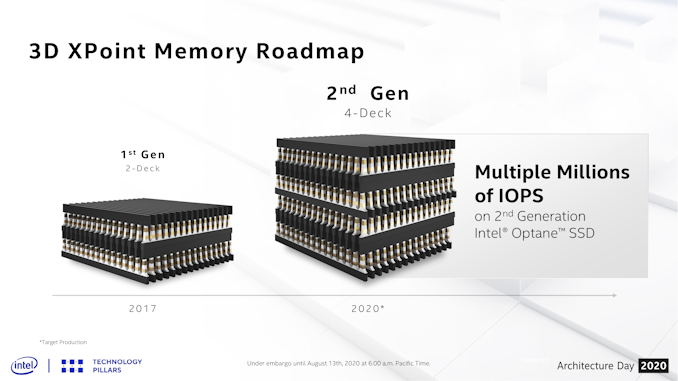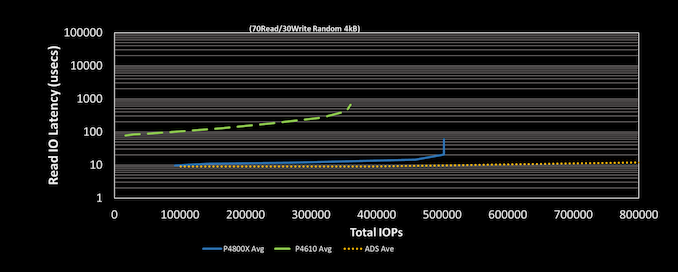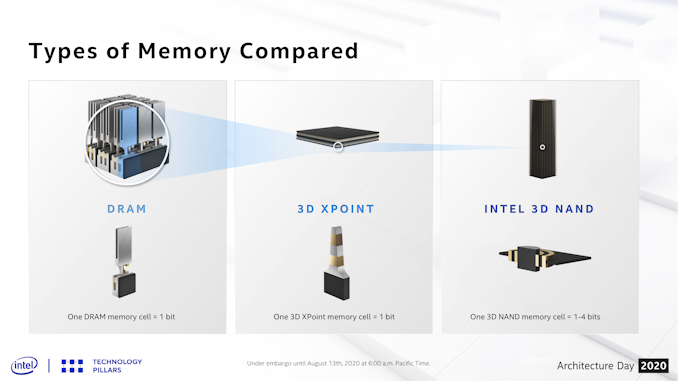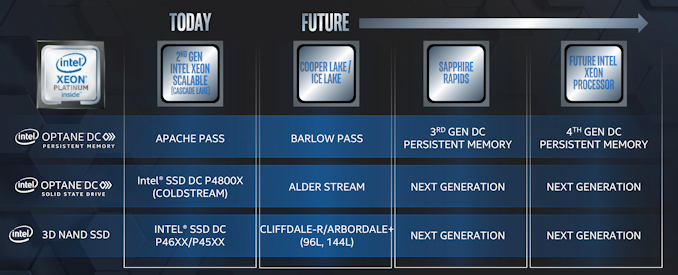Intel Previews 4-Layer 3D XPoint Memory For Second-Generation Optane SSDs
by Billy Tallis on August 13, 2020 9:10 AM EST- Posted in
- SSDs
- Storage
- Intel
- NVMe
- Optane
- PCIe 4.0
- Optane DCPMM
- Intel Arch Day 2020

As part of Intel's Architecture Day 2020 presentations, Raja Koduri spent a bit of time talking about the status of their Optane products. Most of it was a recapitulation of details Intel has previously shared. The two important Optane product updates planned for this year are the Barlow Pass second-generation Optane DC Persistent Memory Modules (DCPMM) and the Alder Stream second-generation Optane NVMe SSDs.
Intel has been teasing their Alder Stream second-generation Optane SSDs since last fall, with promises of off-the-charts performance increases. They've confirmed that Alder Stream will be using second-generation 3D XPoint memory, which moves from two to four layers ("decks" in Intel's slides), making this the first test of the vertical scaling potential of 3D XPoint technology. This combined with with a new SSD controller supporting PCIe 4.0 will enable "multiple millions" of IOPS, more than doubling the throughput of current Optane SSDs. Raja also mentioned that they've made optimizations to single-sector reads, so 4kB QD1 random read latency should be improved a bit as well—but this latency is already substantially limited by the latency of PCIe and NVMe command processing.
Intel recently stated that they have not yet decided where to spun up their own volume manufacturing of 3D XPoint memory, so the second-gen 3D XPoint used in Alder Stream will still be manufactured by former partner Micron and purchased by Intel.
DRAM, 3D XPoint and 3D NAND memories, approximately to scale
Barlow Pass has already launched alongside Cooper Lake Xeons and will be the Optane DCPMM product for Ice Lake Xeons as well. Intel claims an average of 25% higher bandwidth for Barlow Pass than the initial Apache Pass modules for Cascade Lake Xeons.
The fine print in Intel's slides indicates that the 4-deck 3D XPoint memory used in Alder Stream Optane SSDs is not yet in mass production. That and the omission of any mention of the second-generation, 4-deck 3D XPoint memory in the context of Optane DCPMM products all but confirms that Barlow Pass is still using first-gen 3D XPoint memory. This is consistent with the more modest 25% bandwidth increase as compared to the drastic improvements due to arrive with the Alder Stream SSDs. It appears that Ice Lake servers will be getting more advanced Optane SSDs than Optane DCPMM modules, as the next generation of Optane DCPMM isn't due until the launch of Sapphire Rapids processors and the switch to DDR5.













27 Comments
View All Comments
eddman - Thursday, August 13, 2020 - link
I'm a bit confused. Is this second gen 3D xpoint, or second gen optane? I was under the impression the actual second gen 3D xpoint was not ready.Billy Tallis - Thursday, August 13, 2020 - link
The second generation Optane SSDs (due later this year) will use second-gen 3DXP. The second-gen Optane DCPMM (already on the market) still uses first-gen 3DXP.yeeeeman - Thursday, August 13, 2020 - link
They must be stupid to not capitalize on this tech and not go all aboard adding more layers to it.Billy Tallis - Thursday, August 13, 2020 - link
Adding layers to 3DXP is a lot more expensive than adding layers to 3D NAND. Right now, aiming for really high layer counts would end up increasing $/GB. The situation might change as the tech matures, but it'll never be as easy to scale vertically as 3D NAND.Desierz - Thursday, August 13, 2020 - link
I wonder when it will come down in price to compete with NAND. Economies of scale may not apply as much here, since there's only one supplier. I don't think Micron has released anything yet. The X100 can't be bought yet at least. I'm talking both consumer and other products, like NV-RAM, which is tied to Xeon CPUs for now. I assume Micron will engineer them so they work with other architectures. But it sure is taking its sweet time.Slash3 - Thursday, August 13, 2020 - link
Never, it's just the unfortunate reality of the much more complex physical process vs NAND. Which is a shame, as Optane / 3DXpoint is a phenomenal underlying technology.Adler Stream can't come soon enough.
edzieba - Wednesday, August 19, 2020 - link
It's not a fundamental technology limit, more just sheer production volume and time advantage for NAND flash.NAND flash drives were around for decades before the first consumer SSDs, and even then early consumer drives (e.g. the X-25M at ~$7.5/GB) were far more expensive per GB than 3DXP launched at ($4/GB for the DC P4800X, $2.4/GB for the 'Optane Memory drives')!
trivik12 - Tuesday, August 18, 2020 - link
I dont think it has to be cheaper than NAND. This is an enterprise product. What is needed is to up the size, performance across the board and increase DWPD even more. That will ensure its fastest and most enduring storage available. The cost would not matter if you are running critical production data bases or any data analytics/Machine learning. Market for enterprise/cloud would be huge.Plus with cheaper QLC 144 layer SSD for offline storage Intel has products to tackle a market that is growing exponentially.
Cant wait to see how fast optane can be with PCI-E 4.0 interface and new driver. Can Samsung still keep the lead with high end MLC SSD?
plopke - Thursday, August 13, 2020 - link
So they keep improving 3D Xpoint but not fabricating any of it? Micron still producing it all? Did we ever see Micron products ?plopke - Thursday, August 13, 2020 - link
nevermind article still states produced by Micron